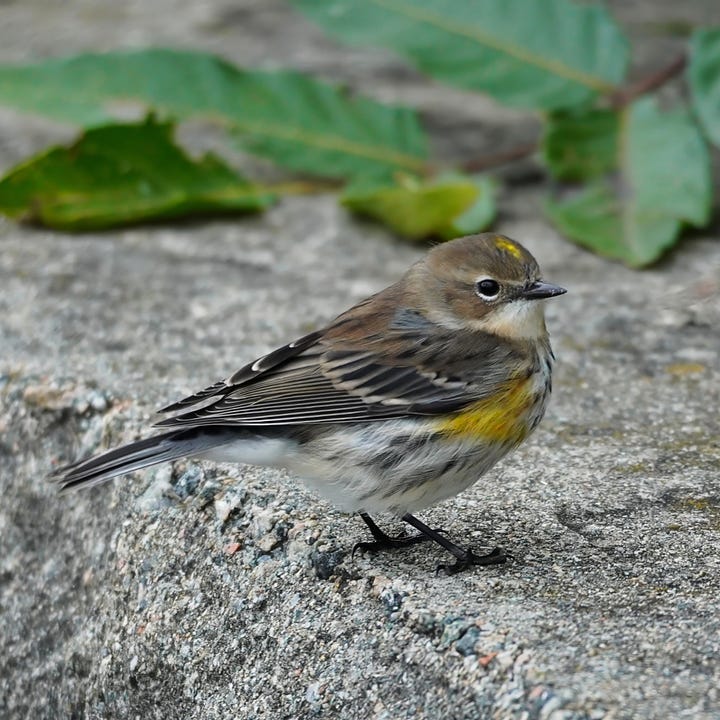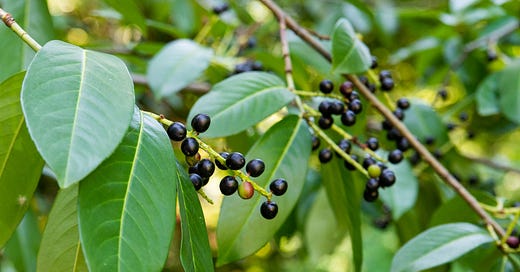UPDATES & ANNOUNCEMENTS
Welcome back!
GROUP DISCOUNT: 30% off anything from Nocs Provisions deal is still alive—no limits on products nor quantity! Field and Pro Issue binoculars are our favs. The photo rig is great for identification. NOTE: We're distributing orders IRL only. DM us your desires!
Sci-curious? Here’s some stuff to do in August (besides—duh—our free Saturday walks):
MICRO-SEASON AUG 5—AUG 11
“My experience is what I agree to attend to. Only those items which I notice shape my mind—without selective interest, experience is an utter chaos.” ― Jenny Odell, How to Do Nothing: Resisting the Attention Economy
Current Japanese micro-seasons: Great rains sometimes fall & Cool winds blow. As for McGolrick Park, perhaps New York City and even larger swathes of the eastern US, we notice—
Spiderwebs appear • Giant foxtail setting seeds • Cherry laurels ripen • Liriope buds • Great rains sometimes fall • First fall migrants appear
Leaves and seeds of the cherry laurel may cause severe discomfort and even death if ingested. Historically, it was used for execution and political assassination in the Roman empire (e.g. Nero) [source]
First migrants were the black-and-white warbler, ovenbird, great crested flycatcher and cedars waxwings—all listed in the below section’s recap. Woo-birdy, what a Saturday
“Setting seeds” simply means the flower has been pollinated and is now growing seeds
AUG 10, 2024 — SATURDAY
Conditions: Perfect • Attendance: ~60 • Vibrations: Also perfect
Saturday birds: Red-tailed Hawk · Black-and-white Warbler · Ovenbird · Laughing Gull (flyover) · Great Crested Flycatcher · Cedar Waxwing · Herring Gull (flyover) · Blue Jay · Chimney Swift · Northern Cardinal… And our 5 urban park besties: Rock Pigeon · European Starling · American Robin · House Sparrow · Mourning Dove
Pic of the day via @peaboy_mitsu:
SHORTY-LESSON: FALL WARBLERS
Our springtime warbler lesson that covered the ~25 commonest-to-NYC warbler species was only a first half!
In fall, breeding male warblers shed spring’s bold fits for feathers that have them looking just like females and juvenile males. These lewks are what we’ll primarily notice when, beginning in August, migrating birds pass back through NYC en route to winter grounds down south.
And this week’s line-up is a DOOZIE:


The Hooded Warbler is an uncommon and beloved migrant who, if recent history is our guide, visits McGolrick Park just a day or two or three a year! In fall, its balaclava fades to varying degrees, creating a topside tan line ranging from black-ish to olive. Another good tell, hard to capture in an image, is its tail, which quickly fans white feathers.


Much more common than the Hooded is the Yellow-rumped. These nationwide birds go gray in fall, with varying degrees of breast stripes bookended by yellow armpits. Look for gray-white, top-bottom contrasting birds, who still rock namesake yellow rectangles on their lower backs, just like in spring.


Yellow Warblers, so striking in spring, go gray → soft yellow in fall. Look for full-body, unstreaked underparts that can really be anywhere on the gray-yellow spectrum.


First of the black-throated warblers is the green, whose olive top + yellow luchador mask remain viewable in fall, but without the namesake black throat. Also note the high contrast black and white wings and breast stripes.


First full costume change of this lesson. Fall’s black-throated blue loses all its namesake parts, instead opting for middle and light grays. Its defined gray face is useful to note. But to be sure you’re black and blue, notice the white pocket square on its wing. See it, picture right? Almost a dot at times, but always visible. Fancy little floof.
BONUS: Black-throated Gray Warbler


Just so we cover all the US’s “black-throated” warblers—last up is the gray, a west-coaster who’ll you’ll virtually never see east of the Rockies. Black-throated gray warblers are heavily masked and striped. Note also their distinctive gold markings betwixt eyes n’ beaks. The overall look is faded in fall, but the hot spot remains.
Reply to this email with questions! Remember: images are always harder to absorb than IRL experiences, which you’ll have—perhaps alongside us, should we be so lucky—soon enough.





